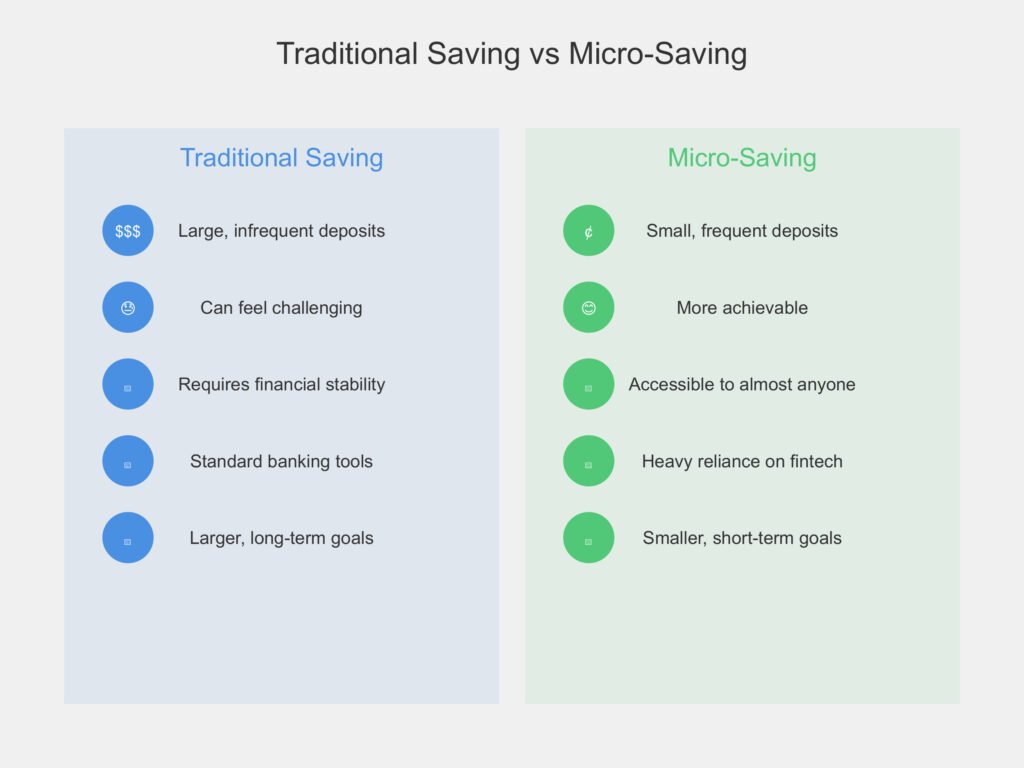In personal finance, saving money has long been emphasized as a cornerstone of financial stability and growth. For decades, traditional saving methods have been the go-to approach for individuals looking to secure their financial future. However, with the advent of technology and a deeper understanding of behavioral economics, a new saving paradigm has emerged: micro-saving.
While both micro-saving and traditional saving aim to help individuals accumulate wealth over time, they differ significantly in their approach, methodology, and psychological impact. This article focuses on the key differences between micro-saving and traditional saving methods, exploring how these distinctions can influence financial behaviors, outcomes, and overall financial health.
Comparison Table: Traditional Saving vs. Micro-Saving
| Aspect | Traditional Saving | Micro-Saving |
|---|---|---|
| Frequency and Amount of Contributions | – Monthly transfers of fixed amounts – Quarterly/annual lump-sum contributions – Saving significant portions of bonuses/tax refunds – Save 10-20% of income | – Rounding up purchases – Daily small transfers ($1 or $2) – Saving a tiny percentage of transactions/paychecks – Emphasis on consistency |
| Psychological Impact | – Can be difficult for tight budgets – May feel like a sacrifice – Clear progress is motivating – “All or nothing” mindset | – Feels more achievable – Creates a sense of constant progress – Reduces psychological barriers – “Every little bit counts” mindset – Frequent positive reinforcement |
| Accessibility and Inclusivity | – Requires financial stability – Challenging for irregular incomes or paycheck-to-paycheck living – Formal banking relationship needed | – Accessible to almost anyone – Suitable for limited disposable income – Utilizes fintech apps, reaches the underbanked |
| Technology and Automation | – Can be automated (monthly transfers) – Uses standard banking tools – Requires more manual oversight | – Relies on technology and automation – Uses AI/machine learning – Integrates with daily financial activities – Minimal active management |
| Goal Setting and Achievement | – Tied to specific, large goals (e.g., house down payment, retirement) – Visible progress – Longer time to see significant results | – Suitable for smaller, short-term goals – Initial progress might seem slow but compounds over time – Immediate gratification from frequent small wins |
| Flexibility and Adaptability | – Fixed commitments (e.g., monthly amount) – Formal adjustments needed for changes – Disrupted by financial emergencies/income changes | – Highly flexible, adapts to financial situations – Easy to scale up or down – Less likely to be derailed by setbacks |
| Investment Potential | – Tied to investment strategies (401(k), IRA) – Higher potential returns through diverse options – Benefits from compound interest due to larger amounts | – Focuses on saving accumulation – Some platforms offer basic investments – Lower potential returns but lower risk |
| Financial Education and Awareness | – Accompanied by education on budgeting, investing, long-term planning – Requires a comprehensive understanding of personal finance | – Builds the habit of saving – Gateway to broader financial education – Increases awareness of spending patterns |

While traditional saving methods and micro-saving share the goal of helping individuals build financial security, they differ significantly in their approach, psychological impact, and accessibility. Traditional saving methods offer the potential for larger, more targeted savings but may be challenging for some to implement consistently. Conversely, micro-saving leverages technology and behavioral insights to make saving more accessible, habitual, and less psychologically daunting.
Ultimately, the most effective saving strategy may involve a combination of both approaches. Micro-saving can serve as an excellent entry point into the saving world and complement traditional methods. By understanding the differences between these approaches, individuals can choose the strategies that best align with their financial situations, goals, and behavioral tendencies.
As the financial landscape continues to evolve, embracing diverse saving methods can provide individuals with the flexibility and tools they need to build a secure financial future, regardless of their starting point or circumstances.

